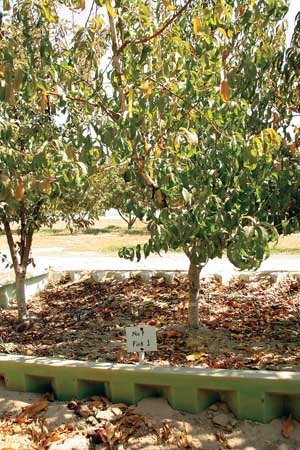Over the years, Dr. Scott Johnson, who retired last year as a University of California extension pomologist, became known for the quality of his research as well as his attention to the cost of inputs to growers.

Scott Johnson grew peach trees in boxes of nutrient-void sand so he could study their nutrient effects and requirements. Photo courtesy of Scott Johnson, University of California.
He conducted research on nutritional needs of peaches and nectarines, fertilizer use efficiency, and how much water was enough, since water in California is a key issue in fruit production.
He proved, for example, that calcium sprays were pretty much a waste of time, producing no benefit on peaches, no matter what the salesmen said or the fact that calcium sprays worked so well on apples.
While it was long thought that peach trees do not take up foliar-applied urea nitrogen, Johnson reasoned that, if they didn’t, they were one of only a few plants that didn’t.
He went on to prove that urea was a great way to get nitrogen into a peach tree. In fact, it was so effective that the nitrogen moved out of the leaves before the researchers could find it, so they thought it wasn’t taken up. Growers now use urea most effectively by applying it before the leaves turn and fall. Nitrogen is effectively applied through the leaves, he said, and urea is an inexpensive way to do it. This doesn’t replace soil applications, but substantially reduces the amount needed.
Where once growers applied 150 pounds of nitrogen per acre, they now use significantly less, with as much as 25 to 50 pounds applied as foliar urea in the fall. Johnson’s trials showed that applying nitrogen in the late fall to soil was a poor choice because nitrogen is taken up only when leaves are present.
Era of research progress
Johnson, who was based at the Kearney Agricultural Center in Parlier, was one of six tree fruit physiologists who spoke this spring at the Cornell In-Depth Fruit School. They were invited to present talks summarizing the work of their careers. For reasons unexplained, the 1970s seemed a great time to enter into tree fruit physiology research, and many who did so are approaching the end of their careers.
Johnson, the extension man who was always focused on reducing grower input costs, was also known for the absolute control he imposed on trees in studying their needs for nutrients and water.
Johnson began studying nutrient deficiency in 2001, when he established 60 peach, plum, and nectarine trees in tanks containing pure sand, nearly devoid of all available nutrients. He began treatments—no nutrients, all nutrients, or all nutrients minus one—nitrogen, phosphorus, potassium, calcium, sulfur, magnesium, and the micronutrients manganese, boron, zinc, copper, iron, and molybdenum.
He even used purified water to absolutely control the nutrient supply. In that way, he found the levels of various nutrients the trees required. Then he studied how best to supply them.
He tested various formulations of materials. To find how best to apply zinc, he studied zinc contained in sulfates, oxides, chlorides, nitrates, carbonates, and more, including some chelates. As a result of that work, he recommends growers use about half a pound of pelletized sulfur and zinc oxide or just straight powdered zinc oxide in the hole at planting time. He also recommends spraying four to eight pounds per acre of zinc sulfate in early fall if trees appear deficient.
Johnson also studied rootstocks. How well did various rootstocks take up nutrients such as zinc?
Zinc is a critical element for peaches. In fact, Johnson said, “Zinc is the main micronutrient we struggle with in all crops, worldwide.”
Johnson participated in the NC-140 regional rootstock trial for peaches.
“It would be nice to have a universal rootstock like Nemaguard that has nematode resistance, is compatible with all scions, but one that is dwarfing,” Johnson said in an article in Good Fruit Grower seven years ago. “We’d like to have that perfect M.9 of the apple industry someday for the peach industry.”
Deficit irrigation
In that same article, he explained his interest in deficit irrigation.
“We are going to run out of water someday,” he predicted, noting that California’s water future is cloudy at best. Some of his fears may be coming true now.
Several years of field trials have shown that growers can withhold irrigation after harvest in early varieties, cutting their water use in half. While trees survive, he found the water reduction resulted in double and deep-sutured fruits the following year, and more split pits.
California soft fruit orchardists annually apply between 3 to 3.5 acre-feet of water, he said. “The research is good information for the day when we only have two acre-feet of water available.”
Thus far, research suggests that the best deficit-irrigation strategy for growers with limited water is to stress the trees only in June and July, but not in August when flower parts for the next season are forming.
For more information, see the article “Research focuses on reducing growing costs,” published in the February 1, 2007, Good Fruit Grower magazine, which can be found in our online archives at goodfruit.com.






Leave A Comment